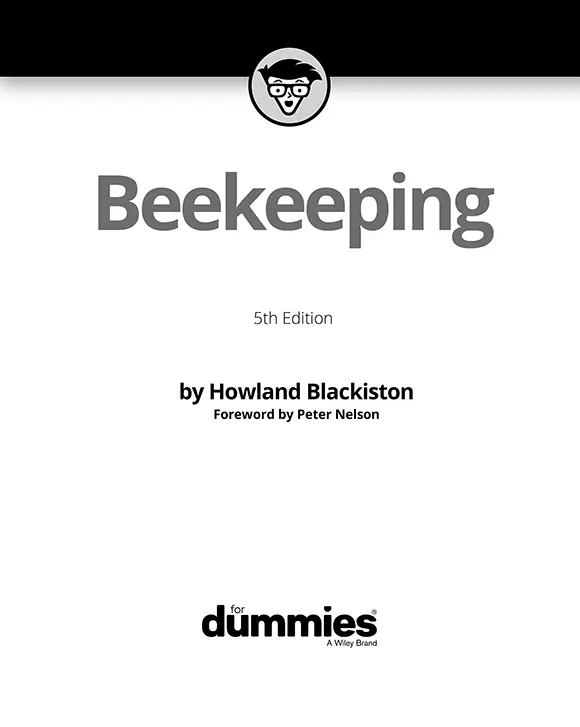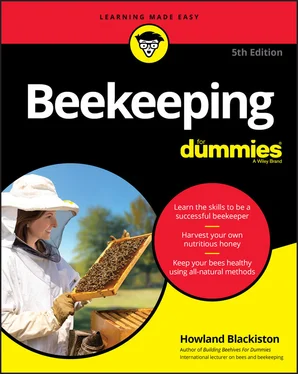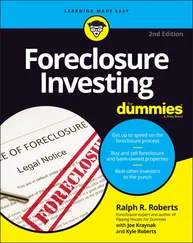
Beekeeping For Dummies®, 5th Edition
Published by: John Wiley & Sons, Inc.,111 River Street, Hoboken, NJ 07030-5774, www.wiley.com
Copyright © 2020 by John Wiley & Sons, Inc., Hoboken, New Jersey
Published simultaneously in Canada
No part of this publication may be reproduced, stored in a retrieval system or transmitted in any form or by any means, electronic, mechanical, photocopying, recording, scanning or otherwise, except as permitted under Sections 107 or 108 of the 1976 United States Copyright Act, without the prior written permission of the Publisher. Requests to the Publisher for permission should be addressed to the Permissions Department, John Wiley & Sons, Inc., 111 River Street, Hoboken, NJ 07030, (201) 748-6011, fax (201) 748-6008, or online at http://www.wiley.com/go/permissions .
Trademarks:Wiley, For Dummies, the Dummies Man logo, Dummies.com, Making Everything Easier, and related trade dress are trademarks or registered trademarks of John Wiley & Sons, Inc., and may not be used without written permission. All other trademarks are the property of their respective owners. John Wiley & Sons, Inc., is not associated with any product or vendor mentioned in this book.
LIMIT OF LIABILITY/DISCLAIMER OF WARRANTY: WHILE THE PUBLISHER AND AUTHOR HAVE USED THEIR BEST EFFORTS IN PREPARING THIS BOOK, THEY MAKE NO REPRESENTATIONS OR WARRANTIES WITH RESPECT TO THE ACCURACY OR COMPLETENESS OF THE CONTENTS OF THIS BOOK AND SPECIFICALLY DISCLAIM ANY IMPLIED WARRANTIES OF MERCHANTABILITY OR FITNESS FOR A PARTICULAR PURPOSE. NO WARRANTY MAY BE CREATED OR EXTENDED BY SALES REPRESENTATIVES OR WRITTEN SALES MATERIALS. THE ADVICE AND STRATEGIES CONTAINED HEREIN MAY NOT BE SUITABLE FOR YOUR SITUATION. YOU SHOULD CONSULT WITH A PROFESSIONAL WHERE APPROPRIATE. NEITHER THE PUBLISHER NOR THE AUTHOR SHALL BE LIABLE FOR DAMAGES ARISING HEREFROM. FULFILLMENT OF EACH COUPON OFFER IS THE SOLE RESPONSIBILITY OF THE OFFEROR.
For general information on our other products and services, please contact our Customer Care Department within the U.S. at 877-762-2974, outside the U.S. at 317-572-3993, or fax 317-572-4002. For technical support, please visit https://hub.wiley.com/community/support/dummies .
Wiley publishes in a variety of print and electronic formats and by print-on-demand. Some material included with standard print versions of this book may not be included in e-books or in print-on-demand. If this book refers to media such as a CD or DVD that is not included in the version you purchased, you may download this material at http://booksupport.wiley.com . For more information about Wiley products, visit www.wiley.com .
Library of Congress Control Number: 2020941825
ISBN 978-1-119-70258-0 (pbk); ISBN 978-1-119-70263-4 (ebk); ISBN 978-1-119-70259-7 (ebk)
Beekeeping For Dummies®
To view this book's Cheat Sheet, simply go to www.dummies.comand search for “Beekeeping For Dummies Cheat Sheet” in the Search box.
Table of Contents
1 Cover
2 Introduction Introduction Keeping honey bees is a unique and immensely rewarding hobby. If you have an interest in nature, you’ll deeply appreciate the wonderful world that beekeeping opens up to you. If you’re a gardener, you’ll treasure the extra bounty that pollinating bees bring to your fruits, flowers, and vegetables. If you’re a foodie, you will celebrate your own honey harvest. In short, you’ll be captivated by these remarkable little creatures in the same way others have been captivated for thousands of years. Becoming a beekeeper is easy and safe — it’s a great hobby for the entire family. All you need is a little bit of guidance to get started. And that’s exactly what this book is for. I provide you with a step-by-step approach for successful backyard beekeeping — follow it closely, and you can have a lifetime of enjoyment with your bees.
About This Book Foolish Assumptions Icons Used in This Book Beyond the Book Where to Go from Here
3 Part 1: Taking Flight with Beekeeping Chapter 1: To Bee, or Not to Bee? Discovering the Benefits of Beekeeping Determining Your Beekeeping Potential Deciding Which Beekeeping Approach to Follow Chapter 2: Getting to Know Your Honey Bees Basic Body Parts The Amazing Language of Bees Getting to Know the Male and the Two Female Castes The Honey Bee Life Cycle Other Stinging Insects
4 Part 2: Starting Your Adventure Chapter 3: Alleviating Apprehensions and Making Decisions Overcoming Sting Phobia Understanding Local Laws and Ordinances Easing the Minds of Family and Neighbors Location, Location, Location: Where to Keep Your Hives Knowing When to Start Your Adventure Chapter 4: Selecting a Hive That’s Perfect for You The Langstroth Hive The Kenyan Top Bar Hive The Apimaye Insulated Hive The Flow Hive The Warré (People’s) Hive The Five-Frame Nuc Hive The Observation Hive Make a Beeline to the Best Beehive Chapter 5: Basic Equipment for Beekeepers Starting Out with the Langstroth Hive Knowing the Basic Woodenware Parts of the Langstroth Hive Knowing the Basic Parts of a Top Bar Hive Ordering Hive Parts Adding on Feeders Fundamental Tools Bee-Proof Clothing Really Helpful Accessories Chapter 6: Obtaining and Installing Your Bees Determining the Kind of Bee You Want Deciding How to Obtain Your Initial Bee Colony Picking a Reputable Bee Supplier Deciding When to Place Your Order The Day Your Girls Arrive Putting Your Bees into the Hive
5 Part 3: Time for a Peek Chapter 7: Opening Your Hive Establishing Visiting Hours Setting an Inspection Schedule Preparing to Visit Your Langstroth or Top Bar Hive Lighting Your Smoker Opening a Langstroth Hive Opening a Top Bar Hive The Hive’s Open! Now What? Chapter 8: What to Expect When You’re Inspecting Keeping a Journal Inspecting a Langstroth Hive Inspecting a Top Bar Hive Understanding What to Always Look For Your New Colony’s First Eight Weeks Chapter 9: Different Seasons, Different Activities Lazy, Hazy, Crazy Days of Summer Falling Leaves Point to Autumn Chores Clustering in a Winter Wonderland Spring Is in the Air (Starting Your Second Season) Managing Top Bar Hives in the Spring The Beekeeper’s Calendar
6 Part 4: Common Problems and Simple Solutions Chapter 10: Anticipating and Preventing Potential Problems Running Away (to Join the Circus?) Where Did the Queen Go? Avoiding Chilled Brood Dealing with the Dreaded Robbing Frenzies Ridding Your Hive of the Laying Worker Phenomenon Preventing Pesticide Poisoning The “Killer Bee” Phenomenon Chapter 11: Colony Collapse Disorder What Is CCD? What to Do If You Suspect CCD Why All the Fuss? What’s Causing CCD? Answers to FAQs What You Can Do to Help Chapter 12: Keeping Your Bees Healthy Understanding the Importance of Good Nutrition Medicating or Not? Knowing the Big-Six Bee Diseases Chapter 13: Heading Off Honey-Bee Pests Parasitic Problems Other Unwelcome Pests Pest Control at a Glance Chapter 14: Raising Your Own Queens Why Raising Queens Is the Bee’s Knees Understanding Genetics What Makes a Queen a Queen Talking about the Birds and Bees for Honey Bees Creating Demand: Making a Queenless Nuc Queen-Rearing Method 1: Go with the Flow Queen-Rearing Method 2: The Miller Method Queen-Rearing Method 3: The Doolittle Method, also Known as Grafting Finding Homes for Your Queens Evaluating the Results The Queen Rearer’s Calendar Marking Your Queens
7 Part 5: Sweet Rewards Chapter 15: Honey, I Love You Appreciating the History of Honey Understanding the Composition of Honey Healing with Honey Choosing Extracted, Comb, Chunk, or Whipped Honey Taking the Terror out of Terroir The Commercialization of Honey Appreciating the Culinary Side of Honey Pairing Honey with Food Infusing Honey with Flavors Judging Honey Honey Trivia Chapter 16: Getting Ready for the Golden Harvest Having Realistic Expectations What Flavor Do You Want? Assembling the Right Equipment to Extract Honey Planning Your Extracted Honey Harvest Setup Gathering Comb Honey Equipment Branding and Selling Your Honey Chapter 17: Honey Harvest Day Knowing When to Harvest Getting the Bees out of the Honey Supers Honey Extraction from a Langstroth Frame Harvesting Honey from Your Top Bar Hive Harvesting Wax
Читать дальше













